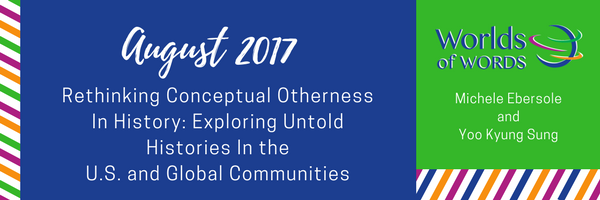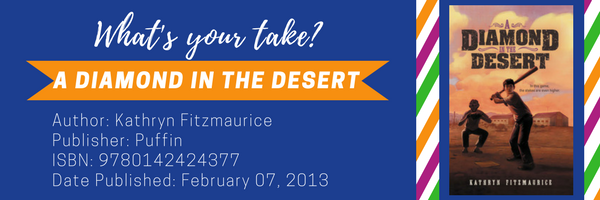 This August, Michele Ebersole and Yoo Kyung Sung give their take on “Rethinking conceptual otherness in history: Exploring untold histories in the U.S. and global communities.” They begin the discussion with the book A Diamond in the Desert by Kathryn Fitzmaurice. In the coming weeks, they also consider Bronze and Sunflower by Cao Wenxua, Gaijin: American Prisoner of War by Matt Faulkner and Lion Island: Cuba’s Warrior of Words by Margarita Engle.
This August, Michele Ebersole and Yoo Kyung Sung give their take on “Rethinking conceptual otherness in history: Exploring untold histories in the U.S. and global communities.” They begin the discussion with the book A Diamond in the Desert by Kathryn Fitzmaurice. In the coming weeks, they also consider Bronze and Sunflower by Cao Wenxua, Gaijin: American Prisoner of War by Matt Faulkner and Lion Island: Cuba’s Warrior of Words by Margarita Engle.

MICHELE: Although this story was written to share with others how baseball brought “hope and a sense of normalcy” (pg. 260) to the Japanese Americans who were interned during WWII, one of the factors that strike me most about this story is the actual telling. The story is told in a fairly unemotional and straightforward tone, which surprises me. Seemingly, the injustices surrounding the internment of the Japanese Americans can be viewed as a politically-charged subject; however, there does not appear to be an attempt to overstate or politicize the events. Despite the many confusing and distressing events experienced, the young adolescent main character, Tetsu, remains composed and mature. There is a great deal of emotional struggle of living within such a physically crowded and what might be perceived as inhumane environment; yet, the characters seem restrained and relatively calm. At the end of the story the author writes, “it took a while for me to understand this, and to grasp what gaman meant. Simply, it is enduring the seemingly unbearable with patience and dignity” (pg. 256). For me, that note explains why the character works hard to restrain himself from reacting impulsively to different events. This concept of gaman is an important cultural concept that helps to explain how the camp residents endure the uncertainty and are able to find reprieve and sanity through building “A Diamond in the Desert” during these trying times.
YOO KYUNG: Thank you, for sharing your observation of tone of emotionality in the Diamond in the Desert. I agree that twelve-year-old Tetsu’s reaction to Japanese internment camp experiences is calm and even accepting. I guess previous books about Japanese internment camps tend to focus on girl protagonists’ resistance against their sudden relocation that is more devastating than understandable. Their unexplained transition and the U.S. government’s unreasonable accusation of Japanese Americans as harmful, stir up mixed feelings from the protagonists. The books, Paper Wishes by Lois Sepahban and Weedflower by Cynthia Kadohata, provoke readers’ emotive reactions.
Living in Japanese internment camps is hard and challenging, especially knowing the setting is in the hot Arizona desert. A Diamond in the Desert is a story of children’s resilience through sportsmanship and boyhood. The situation in an internment camp is difficult, but it is not the center of Tetsu’s thoughts. He wants to fill in his father’s absence and helps his mom and sister. The boys’ resilience and people’s striving attitude for possible normalcy are the central themes of the book. I appreciate how this book portrays that their busy childhood activities distracts from “the interning” reality. What it’s like to be children is magical. Tetsu’s narratives illustrate particular ecology of Gila River in Arizona and in the barracks community. I appreciate the strength of the universal childhood theme, including sibling dynamics, pets, marginalized friends, etc. I wonder if their resiliency is a part of gaman, which you note, that helps characters to stay calm.
Title: A Diamond In the Desert
Author: Kathryn Fitzmaurice
Publisher: Puffin
ISBN: 9780142424377
Date Published: February 07, 2013
This is the first installment of August 2017’s My Take/Your Take. To follow the whole conversation, check the WOW Blog every Wednesday.
- Themes: Diamond in the Desert, Kathryn Fitzmaurice, Michele Ebersole
- Descriptors: Books & Resources, My Take/Your Take, Uncategorized

Yeah… As Michele talks about “gaman” in the “Diamond in the Desert”, the spirit was practiced among many interned Japanese Americans. I think it’s very important cultural concept to understand when we read stories of Japanese internment camps. “Gaman”, persevere and endure, is highly valued attitudes in Japanese culture. I think it helped the interned people to build a sense of normalcy and also to help children’s resilience. “Gaman” is also their ways of showing resistance against racism, injustice, and psychological and physical pains as well, as accepting of reality.
I also see “gaman” practice in the picture book “A Place Where Sunflowers Grow” (2006) by Amy Lee-Tai and Felicia Hoshino as well.
“The Art of Gaman: Arts and Crafts from the Japanese American Internment Camps 1942-1946” (2005, Delphine Hirasuna) shows arts and crafts made by the interned people. It offers people great insights into the impact of the camp experiences on the arts and minds. We can also see how arts played an important role among the people to heal their pains. I think they also expressed “gaman” spirit on their arts.
Here is the slide show of Gaman arts and crafts http://americanart.si.edu/exhibitions/online/gaman/